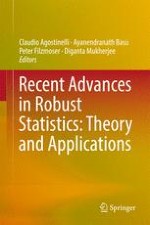2016 | OriginalPaper | Chapter
Determining the Number of Clusters Using Multivariate Ranks
Authors : Mohammed Baragilly, Biman Chakraborty
Published in: Recent Advances in Robust Statistics: Theory and Applications
Publisher: Springer India
Activate our intelligent search to find suitable subject content or patents.
Select sections of text to find matching patents with Artificial Intelligence. powered by
Select sections of text to find additional relevant content using AI-assisted search. powered by
